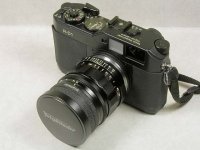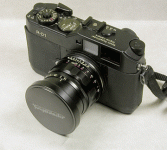jlw
Rangefinder camera pedant
Hello, all --
I had a good month last November with my only paying client, the local art museum -- and since much of what I shoot for them involves low light, I decided to send some of the proceeds to Stephen and invest them in a 35mm f/1.2 Voigtlander Nokton to use on my R-D 1.
So far I've been really pleased with my purchase! Of all the ultra-speed lenses I've ever owned (for me "ultra" means faster than f/1.4) this one is by far the least quirky and most headache-free.
Now, I do enjoy the distinctive look provided by some of my older ultra-speeds, such as the 50/0.95 and 50/1.2 Canons... but sometimes you want a lens that does NOT put such a vivid "signature" on your images! The Nokton is great at this; when I look at the results, I tend to think, "That's a nice picture" rather than "What an interesting effect"...
It's also nice to have an ultra-speed that approximates a "normal" field of view on the R-D 1, rather than the short tele effect of the 50s; sometimes I just can't back up far enough to use a 50. One example of this is the studio rehearsal I attended this afternoon for the Omaha Theater Ballet's upcoming production of Coppélia; I thought I'd post a few of the photos from it to show a couple of reasons why I'm so enthused about the 35/1.2 Nokton:
It's quite sharp even off-axis.
Most of the older ultra-speeds I've used do a good job of rendering a sharp image right smack in the center of the frame... but usually the image gets more "atmospheric" the farther away from the center you get.
The Nokton, on the other hand, gives me more freedom in where I position the subject. I wanted this sweet little girl's eyes to be sharp, but I also wanted to show what she was wearing and how she was sitting -- so I was glad I could compose the picture the way I wanted without being restricted by the lens:

Here's a detail view. All these were at EI 1600 in raw mode, by the way:

It seems very resistant to flare and artifacts from backlighting.
I like dramatic lighting situations, but most of my older ultra-speed lenses don't. At best, they usually flare out and lose contrast, and sometimes they produce exotic-looking optical artifacts. This can be very effective at evoking the atmosphere of, say, a smokey jazz club -- but you don't want everything you shoot to look like a smokey jazz club!
The Nokton seems to pretty much shrug off the effects of shooting into the light. Late in this afternoon's rehearsal, the sun had gotten around to the point where it was coming straight into the windows behind us; I knew I'd be testing my luck to keep shooting, but decided to keep at it because sometimes these "pushing-the-envelope" pictures are more interesting than a technically correct image!
In this case, I decided to use the bright window and foreground shadows as elements in the picture's design. I knew the window and its reflection on the floor would burn out to white (I'm not sure I could have saved them even if I had been shooting on film rather than digitally) but I wasn't too worried about that. What I did want to do was retain detail in the tambourine girl's face, and I'd say the Nokton brought home the bacon:

Here, the backlight wasn't so much an effect I wanted as something I just had to deal with -- the dancers were between me and the window, and I couldn't move, so it was backlight or nuthin'. The rim light around the heads was a nice bonus, but I mostly just wanted to be able to see the action and expressions. Again, I was pleased with the way the Nokton bailed me out:

I've now got fast Voigtlander glass for all three focal lengths covered by the R-D 1's framelines: a 28/1.9 Ultron, the 35/1.2 Nokton, and the 50/1.5 Nokton. These make a very nice combination for the vast majority of my picture-taking; I still enjoy using my "vintage" lenses, too, but now I can reserve them for times when I want to take advantage of their distinctive peculiarities!
I had a good month last November with my only paying client, the local art museum -- and since much of what I shoot for them involves low light, I decided to send some of the proceeds to Stephen and invest them in a 35mm f/1.2 Voigtlander Nokton to use on my R-D 1.
So far I've been really pleased with my purchase! Of all the ultra-speed lenses I've ever owned (for me "ultra" means faster than f/1.4) this one is by far the least quirky and most headache-free.
Now, I do enjoy the distinctive look provided by some of my older ultra-speeds, such as the 50/0.95 and 50/1.2 Canons... but sometimes you want a lens that does NOT put such a vivid "signature" on your images! The Nokton is great at this; when I look at the results, I tend to think, "That's a nice picture" rather than "What an interesting effect"...
It's also nice to have an ultra-speed that approximates a "normal" field of view on the R-D 1, rather than the short tele effect of the 50s; sometimes I just can't back up far enough to use a 50. One example of this is the studio rehearsal I attended this afternoon for the Omaha Theater Ballet's upcoming production of Coppélia; I thought I'd post a few of the photos from it to show a couple of reasons why I'm so enthused about the 35/1.2 Nokton:
It's quite sharp even off-axis.
Most of the older ultra-speeds I've used do a good job of rendering a sharp image right smack in the center of the frame... but usually the image gets more "atmospheric" the farther away from the center you get.
The Nokton, on the other hand, gives me more freedom in where I position the subject. I wanted this sweet little girl's eyes to be sharp, but I also wanted to show what she was wearing and how she was sitting -- so I was glad I could compose the picture the way I wanted without being restricted by the lens:

Here's a detail view. All these were at EI 1600 in raw mode, by the way:

It seems very resistant to flare and artifacts from backlighting.
I like dramatic lighting situations, but most of my older ultra-speed lenses don't. At best, they usually flare out and lose contrast, and sometimes they produce exotic-looking optical artifacts. This can be very effective at evoking the atmosphere of, say, a smokey jazz club -- but you don't want everything you shoot to look like a smokey jazz club!
The Nokton seems to pretty much shrug off the effects of shooting into the light. Late in this afternoon's rehearsal, the sun had gotten around to the point where it was coming straight into the windows behind us; I knew I'd be testing my luck to keep shooting, but decided to keep at it because sometimes these "pushing-the-envelope" pictures are more interesting than a technically correct image!
In this case, I decided to use the bright window and foreground shadows as elements in the picture's design. I knew the window and its reflection on the floor would burn out to white (I'm not sure I could have saved them even if I had been shooting on film rather than digitally) but I wasn't too worried about that. What I did want to do was retain detail in the tambourine girl's face, and I'd say the Nokton brought home the bacon:

Here, the backlight wasn't so much an effect I wanted as something I just had to deal with -- the dancers were between me and the window, and I couldn't move, so it was backlight or nuthin'. The rim light around the heads was a nice bonus, but I mostly just wanted to be able to see the action and expressions. Again, I was pleased with the way the Nokton bailed me out:

I've now got fast Voigtlander glass for all three focal lengths covered by the R-D 1's framelines: a 28/1.9 Ultron, the 35/1.2 Nokton, and the 50/1.5 Nokton. These make a very nice combination for the vast majority of my picture-taking; I still enjoy using my "vintage" lenses, too, but now I can reserve them for times when I want to take advantage of their distinctive peculiarities!
Last edited:



